Are you a Quiet Speculation member?
If not, now is a perfect time to join up! Our powerful tools, breaking-news analysis, and exclusive Discord channel will make sure you stay up to date and ahead of the curve.
As of this writing, a playset of Ancestral Vision will set you back 140 tickets on MTGO. Sure, some of that is finance garbage due to Snapcaster Mage and fetches being in MM3, but even before that the card was 25+ tickets. Corey Burkhart (and now Shaheen Soorani) have been in the spotlight in recent weeks pushing the merits of Ancestral Vision, specifically in Grixis Control. Vision's pedigree in Modern is thin, to be sure, but it continues to be one of the most intriguing spells from a deckbuilding perspective, regardless of the lack of high-quality tournament finishes to its name. Is Ancestral Vision a spell worthy of being counted among the likes of Terminate, Serum Visions, and Thoughtseize? Or is the card a trap, a beacon of card advantage luring unsuspecting control mages into its clutches?

Today, I intend to find out the answer to these questions. This is Ancestral Vision: A Case Study.
[wp_ad_camp_1]
The Raw Rate
No spell in Modern exists independent of context, but if we are to understand the merits of the spell, step one is gaining a clear understanding of its strengths and weaknesses based on rate alone. For one mana we get three cards, on a four-turn delay. So, playing Ancestral Vision on our first turn means we’re casting it off suspend at the beginning of our fifth turn. How powerful is this? The logical first step is to compare AV to other cantrip options out there, so we’ll start there.
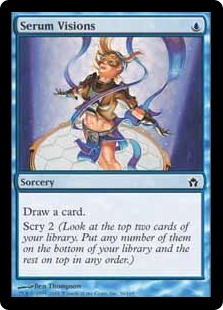 Serum Visions gets us one card for one mana, but almost all of the power comes from the scry 2. Setting up our next draw (or possibly next two draws) is really what sets Serum Visions apart from the crowd, compared to other options like Thought Scour (better for fueling delve/graveyard synergies) and Sleight of Hand (more interested in the quality of that one card). The random draw aspect of Serum Visions is by far the worst part of the cantrip (you know, the cantrip part), but scry 2 for {U} absolutely wouldn’t cut it. So, replacing itself for one {U} is a necessity, but to be “better” than Serum Visions we’re looking for something comparable to the scry 2. Two extra random cards is better than reorganizing the top two by far, but not getting those cards until four turns later is a big deal.
Serum Visions gets us one card for one mana, but almost all of the power comes from the scry 2. Setting up our next draw (or possibly next two draws) is really what sets Serum Visions apart from the crowd, compared to other options like Thought Scour (better for fueling delve/graveyard synergies) and Sleight of Hand (more interested in the quality of that one card). The random draw aspect of Serum Visions is by far the worst part of the cantrip (you know, the cantrip part), but scry 2 for {U} absolutely wouldn’t cut it. So, replacing itself for one {U} is a necessity, but to be “better” than Serum Visions we’re looking for something comparable to the scry 2. Two extra random cards is better than reorganizing the top two by far, but not getting those cards until four turns later is a big deal.
How big, exactly? Well, that sort of thing is hard to quantify, so we’ll have to go the theoretical route. For the purposes of these hypothetical scenarios, we’ll assume we’re playing AV in a reactive midrange/control strategy, though we’ll see later that this assumption is not always the case. In practice, Serum Visions is often used to set up our plan for the next turn or two, by digging for a specific card and then crafting our strategy around those options. Think “finding a Terminate on top,” or “playing towards that Cryptic Command we just set.” The random draw comes into play sometimes, but usually the card we find immediately from casting Serum Visions isn’t being played that turn (though it definitely happens).
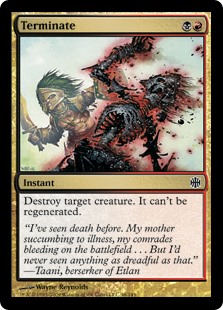 Of course, there’s also the added value that Serum Visions provides by letting us “cheat” on lands. A playset of Serum Visions usually lets us play one fewer land, and I’ve seen some discussion that the math works out closer to 1.5 to 2 lands. With a one-lander, Seurm Visions lets us dig potentially four cards deep to find the second land (one from the draw, bottoming two, fourth card comes from the natural draw next turn). Cast on an early turn, Serum Visions usually translates into a 36% chance to turn into a land with a free scry two. If we’re talking consistency and smoothing out our land drops, Serum Visions blows Ancestral Vision out of the water.
Of course, there’s also the added value that Serum Visions provides by letting us “cheat” on lands. A playset of Serum Visions usually lets us play one fewer land, and I’ve seen some discussion that the math works out closer to 1.5 to 2 lands. With a one-lander, Seurm Visions lets us dig potentially four cards deep to find the second land (one from the draw, bottoming two, fourth card comes from the natural draw next turn). Cast on an early turn, Serum Visions usually translates into a 36% chance to turn into a land with a free scry two. If we’re talking consistency and smoothing out our land drops, Serum Visions blows Ancestral Vision out of the water.
So where does that put us? To summarize, Serum Visions immediately replaces itself, sets up our next turn, helps to avoid drawing air (or hit land drops) and lets us cheat on around 1.5 lands. By contrast, Ancestral Vision gets us two extra cards “for free” in the sense that we’re paying ahead of time, with the downside being that we’re waiting a full four turns to get those cards.
In Practice
Assuming we’re playing Ancestral Vision, we’ve suspended it on our first turn, and we’re alive as it comes off suspend, what kind of effect can we expect that to have on the game? Let’s break down the knowns and see what AV’s best-case impact can be.
Let's assume a normal sequence of interaction, where both players keep their opening sevens, hit their land drops, and cast relevant spells on each turn. We'll assume that by turn four each player has mana to cast two spells if available in hand. Given all that, here's what we can expect the game log to look like on the upkeep of our fifth turn:
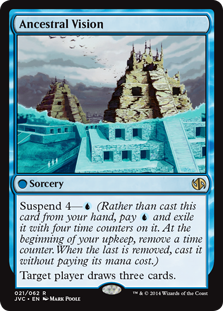 Us, T1: Land, Vision, go. (5 cards)
Us, T1: Land, Vision, go. (5 cards)
Them, T1: Draw, land, go. (7 cards)
Us, T2: Draw, land, go. (5 cards)
Them, T2: Draw, land, spell. (6 cards) We interact. (4 cards)
Us, T3: Draw, land, go. (4 cards)
Them, T3: Draw, land, spell, go. (5 cards) We interact. (3 cards)
Us, T4: Draw, land, go. (3 cards)
Them, T4: Draw, spell, spell, go. (3 cards) We interact twice. (1 card)
Here, it looks like we’re on the ropes. Down a card since we went first, and a second since Ancestral Vision has been languishing in exile all game, we are sitting on one card while our opponent has three in hand. Assuming we’ve answered our opponent’s threats effectively, haven’t been flooded, don’t have a Spell Snare or "dead” removal in hand, we’re still behind and need something to come back to parity.
Us, T5: Cast Vision, draw 3, draw for turn, land, go (4 cards)
If you were able to follow along with the math, what Ancestral Vision provides for us is clear: a quick, easy way back to parity. Control decks fill their list with card advantage spells for a reason—playing control strategies with the intention on hitting higher land drops gives them inherent card disadvantage. Playing 26 land, with the hopes of both hitting a land drop and casting a piece of interaction every turn will result in running out of cards faster than an opponent playing 21 lands and casting almost nothing but threats past the fourth land drop. Every time.
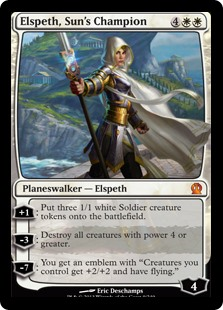 This is why the best control spells replace themselves, or provide more than a card’s worth of value. Snapcaster Mage comes with a free spell attached. Serum Visions finds us exactly what we need, or at least just gas. Elspeth, Sun's Champion can’t be answered with one card (besides Mana Leak). Snapcaster Mage, Kolaghan's Command, Cryptic Command, Liliana of the Veil, Think Twice—the list goes on and on. Ancestral Vision is pure card advantage on a timed fuse.
This is why the best control spells replace themselves, or provide more than a card’s worth of value. Snapcaster Mage comes with a free spell attached. Serum Visions finds us exactly what we need, or at least just gas. Elspeth, Sun's Champion can’t be answered with one card (besides Mana Leak). Snapcaster Mage, Kolaghan's Command, Cryptic Command, Liliana of the Veil, Think Twice—the list goes on and on. Ancestral Vision is pure card advantage on a timed fuse.
Control mages live for the times when we’re at parity with our opponent (they are at one card, we are at one card) and we cash in on Ancestral Vision and go up to five cards out of nowhere. In those cases, assuming we didn’t draw three lands or are facing down an untenable board position, merely drawing extra cards is enough to warrant a confession. Just ask Sphinx's Revelation. In those situations, Ancestral Vision is a true “win condition,” in the sense that it's the card we cast to make our opponent concede. But its real power comes from letting us devote the rest of our deck to interaction.
What I mean by that is this: due to the inherent card disadvantage present from playing a higher land count and being “reactive” in a diverse field of threats, control decks will almost always be behind at some point in a normal match. Mana Leak is drawn too late, Lightning Bolt doesn’t hit Tarmogoyf, we drew a few too many lands while our opponent “got lucky” and drew all action (even though that’s how math works)—the scenarios are endless. Goblin Dark-Dwellers, Nahiri, the Harbinger, Sphinx's Revelation, Kalitas, Traitor of Ghet, and other expensive spells like them are designed to be the top end of a reactive curve that can turn the corner and generate more than a card’s worth of value to pull us ahead. 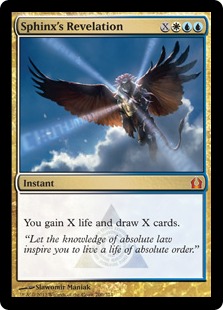 These “win condition” spells are powerful, but also a death sentence at the beginning of the game, as anyone familiar with the concept of curve in Magic knows by now.
These “win condition” spells are powerful, but also a death sentence at the beginning of the game, as anyone familiar with the concept of curve in Magic knows by now.
This is where Ancestral Vision’s hidden power shines. Assuming we have the capability to answer almost anything, just drawing enough cards is a legitimate path to victory, and we don’t need to play any expensive bombs to win. AV is our bomb, and it costs one blue.
So which one is "better," and does it even matter? Serum Visions has its merits, but the true difference between the two is the fact that Serum Visions is better at keeping us ahead and providing small advantages, while Ancestral Vision is the card that helps us get out of bad spots. AV is good in our opener, but poor late (though not useless, unlike discard) while Serum Visions is good at all stages of the game, and its value increases as the game goes on. If I had to pick one, I would choose Serum Visions, as consistency and flexibility are in higher demand in Modern than true power. But they both have their merits, and do different enough things, that it’s difficult to pick one over the other.
Metagame Context
We know now exactly what we’re getting with Ancestral Vision, but how do those strengths and weaknesses line up against the field? Last week I talked specifically about my thoughts regarding AV in aggressive matchups. For those who missed it, the main point was this:
"Aggression as a defining format characteristic is actually a reason for discard, in my mind, rather than against, for a couple of reasons. Disrupting curve for a single mana can often offer returns much greater than the initial mana investment. Taking our opponent’s three-drop and forcing them to waste mana by playing inefficiently is one of the interactions that’s integral to Grixis Control’s success as an archetype. It’s not enough to just trade one-for-one and hope our answers align perfectly with their strengths; true victory is attained when we can maximize value in critical situations and force our opponent to stumble at an important juncture."
Why am I talking about discard in an article about Ancestral Vision? In some cases, I believe the two go hand in hand, strengthening each other. One of the best ways to fight Ancestral Vision is with discard, and one of the best ways to fight discard is with discard of our own.  If our goal is to disrupt our opponent's curve, trade resources to run them out of spells, and then turn the corner quickly, Ancestral Vision can serve as a cheap, powerful spell at the top end of our curve to either pull us back from the brink or close the door on our opponent entirely.
If our goal is to disrupt our opponent's curve, trade resources to run them out of spells, and then turn the corner quickly, Ancestral Vision can serve as a cheap, powerful spell at the top end of our curve to either pull us back from the brink or close the door on our opponent entirely.
Still, for the most part, AV is a better spell when we know we can live to turn five with relative certainty (so, slow combo, midrange and other control strategies). Again, that’s not to say the card is bad in aggressive metagames. It's just less “awkward” when we don’t have to choose between killing Goblin Guide and suspending Ancestral Vision on turn one.
AV tends to be a solid option in a field that contains a large amount of discard. While it feels bad to get our Vision taken away by a Thoughtseize, we have to remember that that Thoughtseize was taking our best card regardless. On the other hand, sneaking in an Ancestral Vision under their discard (or if they just don't have it) punishes them for attacking our hand instead of our life total. Every mana they spend "interacting" with our resources rather than playing to the board just sets them farther behind for the eventual free cards when it comes off suspend. Currently, Death's Shadow Aggro, Junk, and Jund Midrange all employ discard to great effect, and Ancestral Vision is a great option against all of them.
Ancestral Vision also preemptively fights most opponents’ usual strategy for fighting control decks in sideboarded games. Postboard, many archetypes employ card advantage elements of their own, disruption, and alternative threats against us in an attempt to throw us off balance. 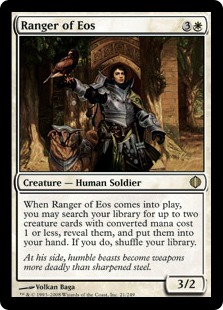 Ranger of Eos, Thoughtseize, and Jace, Architect of Thought can be tough to fight all at once, but Ancestral Vision does a solid job. More cards equals more resources to fight with, and often that’s the best (or only) way to fight against a diverse number of strategies being employed against us.
Ranger of Eos, Thoughtseize, and Jace, Architect of Thought can be tough to fight all at once, but Ancestral Vision does a solid job. More cards equals more resources to fight with, and often that’s the best (or only) way to fight against a diverse number of strategies being employed against us.
Conclusion
Ancestral Vision lends itself to a control strategy that seeks to draw the game out through reactive elements and win through card advantage once it has successfully answered opposing threats. Most of the time, Ancestral Vision is played in true control strategies like Jeskai Control, Grixis Control, and Esper Control. Though it has also been used to some effect in tempo strategies like Grixis Delver or Temur Traverse, or as a sideboard option for decks with access to blue mana against opposing slower strategies. The card is strong, but not without its faults—choosing to include it in our deck can (and should) influence the rest of our deck composition. It is at its best in slower metagames, but can be used to great effect in aggressive matchups as well. Should you choose to use it, may it bring you great fortune!
Thanks for reading,
Trevor Holmes





I love Modern Nexus, but honestly was this much in depth analysis pf AV really nescessary to say conclusively that it belongs in control decks?
I feel like this conclusion was kind of wishy-washy, to be honest. You didn’t commit firmly to whether you thought it was worth playing in the current metagame or not. I’m of the opinion that it is, and that it’s one of the big reasons Grixis Control does well in fair deck mirrors – most fair decks can’t kill you through disruption before it goes off, and they usually can’t deal with the card advantage that you get out of it. It’s a little shakier against streamlined aggressive strategies, but it usually slams the door shut hard once you do resolve it.
I believe the reason for the wishy-washiness is bc the answer is fluid. Mtgo meta, fmn, States, Gran Prix….overall, I’m sure it’s a fine inclusion since we can all agree that modern has slowed down. For how long though…? Then the evaluation on AV changes again; From good/solid to unplayable.